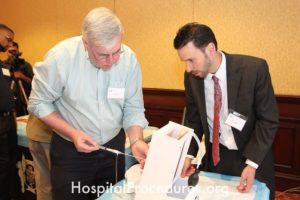Thoracentesis is one of the most common bedside procedures performed in U.S. hospitals. There are about 173,000 thoracenteses performed each year in the U.S. A systematic review and meta-analysis in 2010 concluded that thoracentesis-related pneumothorax occurs 6% of the time overall, but only 2% of the time with ultrasound-guided thoracentesis.1 Now, Dr. Mark Ault and colleagues have published a single center cohort study of all 9320 thoracenteses at Cedars-Sinai Medical Center between 2001 and 2013.2
Dr. Ault demonstrated that the complication rate for ultrasound-guided thoracentesis in the hands of experienced operators is very low. The rate of pneumothorax was only 0.6%, the rate of re-expansion pulmonary edema was only 0.01%, and the incidence of significant bleeding was about 0.2%. The protocol used included site marking with a portable ultrasound and the use of a safety-tipped needle/catheter system (e.g., Safe-T-centesis kits). Manual aspiration was used for therapeutic thoracenteses. Blood products were not used for either thrombocytopenia or coagulapathy prior to the thoracenteses.
Although the incidence of complications was low, the risk of a pneumothorax was statistically associated with removal of more than 1,500 mL fluid, more than one pass to attain fluid, and underweight patients. Traditional guidelines for thoracentesis, such as those published by the British Thoracic Society in 2010, state that patients on warfarin anticoagulation should have the INR corrected to 1.5 or less and patients with a platelet count less than 50,000 should have a platelet transfusion prior to a thoracentesis because of the risk of bleeding.3
This cohort study performed their ultrasound-guided thoracentesis procedures on anticoagulated patients or with platelet counts as low as 20,000 without any pre-procedure blood product administration. In addition, some patients on Clopidogrel (Plavix) underwent thoracentesis without platelet administration and the overall risk of bleeding complications was only 0.2%.
Although the results are very impressive, the study should be interpreted cautiously since all procedures were performed by very experienced procedural experts. Therefore, I still encourage a more cautious approach for most hospitalists, intensivists, emergency physicians and midlevel providers performing thoracentesis. I advocate for universal ultrasound-guided thoracentesis and manual aspirations for therapeutic thoracenteses. I also believe that most practitioners should be very cautious if performing a thoracentesis when their patient has an INR>1.8 on warfarin, takes clopidogrel or prasugrel or any of the new oral anticoagulants, has uremia, or if the platelet count is below 40-50,000.

- 1. Gordon, CE et al. Pneumothorax following thoracentesis: a systematic review and meta-analysis. Arch Intern Med. 2010; 170: 332-9.
- 2. Ault, MJ et al. Thoracentesis outcomes: a 12-year experience. Thorax. 2015; 70: 127-132.
- 3. Havelock T et al. Pleural procedures and thoracic ultrasound: British Thoracic Society pleural disease guideline 2010. Thorax. 2010; 65 (suppl 2): ii61-76.
